Introduction to Delta Pieces: Northeast Louisiana Folklife
Map: Cultural Micro-Regions of the Delta, Northeast Louisiana

The Louisiana Delta: Land of Rivers








Ethnic Groups










Working in the Delta








Homemaking in the Delta



Worshiping in the Delta



Making Music in the Delta




Playing in the Delta







Telling Stories in the Delta



Delta Archival Materials
Bibliography

Traditional Boats of Catahoula Lake
By Dayna Bowker Lee
The systems involving small craft include not only fishing gear and boat-building tools, but also elaborate means of trade . . . matters of status...and cultural wisdom essential to success in an occupation where man interacts directly with nature....
-- Henry Glassie1
A strong boating tradition has long been present in the state of Louisiana. The extensive waterways of the state have provided access to most major locales by means of small craft. Not only do these waterways continue to provide transportation and lines of communication, but they are also important economic resources. The boating tradition is associated primarily with southern Louisiana, but it is also strong in the Mississippi floodplain, especially in the area of Catahoula Lake.
Catahoula Lake is an approximately 33,000 acre lake located in LaSalle Parish, Louisiana. It is an ephemeral water body, at flood times filled with waters of up to forty feet, and in other seasons so dry that cattle can be grazed on the lake bed and hay harvested from it, as well. The lake waters can change so suddenly that, according to Vernie Gibson, "Water that was five foot one day will be twelve foot the next day you fish it." The Catahoula Lake complex involves a variety of environments--lacustrine, riverine, bayou, backswamp, and marsh--each providing a separate ecosystem, and each impacted by the activities of man. Wooden boats have been developed that utilize these environments to their maximum efficiency, some adapting to changes in these ecosystems, some remaining basically the same through time.
In "Folk Boats of Eastern French Louisiana,2 William Knipmeyer identifies two general characteristics of small folk boats in Louisiana: 1) they are carvel-built; that is, planks are placed edge to edge to give the hull a smooth appearance; 2) they are flat-bottomed; if a keel is used, it is always external.3
The exception to these restrictions is the dugout canoe, dealt with below. The remaining Catahoula Lake boat types adhere to Knipmeyer's characteristics, and are identified by type, use, and construction.
The Dugout
The dugout evolved from the ancient design of Indians inhabiting the southeastern United States. As documented by Le Page de Pratz in 1774, the Indians constructed craft of some thirty to thirty-five feet long made from a single log, generally cypress, poplar, or tupelo gum. Before European introduction of the steel axe a ring of fire was kindled around the base of the tree to be used for the dugout. In this long and tedious process, the tree was eventually felled and hollowed out. Wet clay was used to form a barrier that prevented the fire from spreading beyond the desired perimeter. The outside was formed in the same fashion. The bottom of the canoe was not entirely rounded, but flattened slightly near the widest part of the center. The bottom ran to a slight ridge at either end, and the sides were curved and slightly flaired.4
Production of dugouts today is rare. Mickey Barron, whose father made dugout canoes in the 1940s, cannot recall one having been crafted in the area for more than thirty years. She says "Nobody I know, nowhere, knows how to make a dugout. It takes a real good, straight cypress log with no knots to make one." The scarcity of cypress logs large enough to construct a dugout, and the technical ability involved, almost precludes their production today. Dugouts were generally twenty to thirty feet long, but those produced most recently were seldom more than fifteen feet long, attributable to decreasing availability of large trees.
When the "big" cypress were abundant, the boat builder would enter the swamp, search out his tree, and mark it to be cut later. When the water rose, he went in, cut the log, and floated it out.
The log was cut to the desired length and then halved, so that there were two basically equal pieces. Mickey remembers her father boring holes into the log with a brace and bit, a tool used for boring, inserting wedges into the augered holes, and splitting the log in two. Tools used in the manufacture of a dugout included a long-handled foot adze, hatchet, plane, draw-knife and short-handled, deeply curved hand adze also called a boat howl. The adze held by Margaret Sanson in Plate 1 is a boat howl or tille ronde, made from a cane hoe.5 After the log was split, a line was drawn lengthwise down its center; no templates or patterns were used. The outside was formed first, using primarily the foot adze and hatchet. When the outside was roughed out, auger holes were placed in the gunwales, the sides of the boat, to determine how thick they were to be. The holes were then pegged. The boat-form was inverted and the inside was hollowed using the foot adze, hatchet, and the hand adze. When the wood was dug down to the pegs, the boat was smoothed inside and out with the aid of a plane and sandpaper.6
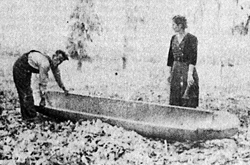
The time involved in the creation of a dugout varied from builder to builder. Mickey Barron and her brother Boone Kitchens, remember their father taking several months, from the procurement of the log to the finished dugout, however Emerick Sanson could construct one in about fifteen days.7 Cyrus Kitchens was primarily a trapper and farmer, and worked on boats when he could, which may explain the disparity.
Dugouts on Catahoula Lake were used in the marsh and swamp for, among other things, the trapping and transporting of wild hogs. Cyrus Kitchens lined the bottom of his dugout with hogs trussed for transporting from low to high ground in flood times.8 They were also used as a means of transportation within limited areas.
The design of the dugout was an asset for working in marsh and swamp environments, although the craft could also be used on open water. A dugout could be paddled from either side and, if the need arose, could be reversed as well. In swampy areas, cypress knees and submerged logs are a danger. The solid body of the dugout would generally prevent a hole being knocked into its hull.
It was possible, but not desirable, to patch a dugout. In Plate 1, Emerick Sanson is patching the bow of a dugout. If a hole occurred in the hull of the dugout, the hole was squared, and a piece of wood was cut to fit it. The patch was caulked and glued into the hole and then sanded to conform to the shape of the boat. There was always a chance of leakage, but it was preferable to the loss of the boat.
When not in use, dugouts were generally stored underneath the house, sometimes packed with moist Spanish moss, to prevent drying and cracking. If kept in a damp, closed environment, the cypress wood of the dugout could be preserved for many years.
The Plank Pirogue
The boat that has assumed the function of the dugout on Catahoula Lake is the plank pirogue. It obviously evolved from the dugout, being similar in size, design, and use.
Marine plywood, a strong, water-resistant pine plywood used to build most small working boats today, is used to make plank pirogues. Solid cypress was used in the past; but, again, the scarcity of large cypress trees precludes its use today. The headblock and tailblock, solid pieces in the bow and stern of the boat, are still made of cypress. The bottom piece is cut from a single piece of plywood, as are the gunwales, commonly called "gunnels." As with all wooden working boats except the dugout, the frame of the pirogue is constructed first, then attached to the bottom.
The gunwales are first beveled; that is, the center of the board is marked two inches from the bottom, tapering to zero on either end (Plate 2). This piece is then cut out using a skill saw. When the gunwales are bent and attached to the blocks, the beveling allows each end of the pirogue to rise slightly out of the water. The gunwales are aligned lengthwise, the way they will be placed on the finished boat, and spreaders are placed eight inches from each block. Spreaders are the supports on either end from which the gunwales are bent and attached to the blocks, achieving the pointed ends. Timbers, or bottom supports, are placed approximately fifteen inches apart down the entire length of the boat, and are attached to the gunwales one by one. The timbers graduate in size from small to larger from each block to the center, the widest timber achieving the desired flair of the pirogue. The flair is the area where the gunwales are the most distant from each other (Plate 2).
The headblock, then the tailblock, are attached next. The process on either end is the same on the pirogue, since the bow and stern are virtually identical. The gunwales are pulled in to meet the blocks and are attached. The boat is constructed, as are all small working boats, using carpenter's glue and galvanized nails. It may or may not be painted with a copper-based sealant, then it is painted with an oil-based paint. Boats are removed from the water and painted on the average of twice a year with the paint filling any cracks and insuring a better seal.
The plank pirogue is used in places and situations where the dugout was formerly used. It was employed in cypress lumbering activities in south Louisiana9, as well as on Catahoula Lake. Vernie Gibson remembers being paid $2.12 per ten-hour day in 1919 for "wildcatting cypress" on Big Bayou. The harvesting of cypress logs in this manner was extremely dangerous and required two men in pirogues, one on either side of the tree, sawing together. When the tree began to fall, the boats were shoved away in directions opposite the falling tree. It was predetermined which man would be responsible for holding onto the saw. The "wildcatters" often went three to four miles into the swamp hunting the disappearing cypress.10
Plank pirogues remain popular today, especially among trappers and fishermen.
The Flatboat
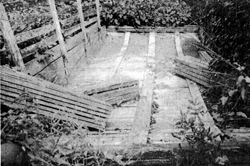
The flatboat was used to transport goods, animals, and people to areas of high ground during periods of inundation. When cattle were open-grazed on Catahoula Lake, flatboats enclosed by pens (pen boats) were used to transport them from one area to another. Flatboats were an invaluable asset to the inhabitants of the lake, providing a safe exit from low-lying areas. All in-formants recalled having used a flatboat for transportation at times. They were also used for seine-fishing.
The flatboat in Plate 3, owned by John S. Allen, was last used in the 1973 high waters. It has been beached since then, but the solid design of the boat would allow it to be used again after minor repair.
The flatboat was usually constructed of cypress lumber and was built to the desired specifications of its maker.
The Houseboat
Many of the older residents of Catahoula Lake were born and reared11 on houseboats, also called "camp boats or shanty-boats." They were usually tied to the bank of one of the lake's many tributaries. A self-professed "river rat," a term applied to houseboat dwellers, Vernie Gibson recalls the houseboat built by his father. The house superstructure was built on a hull constructed of four-inch gunwales, tapering slightly up at either end and a bottom of two-inch heart cypress. Mr. Gibson said that the gunwales were made of fir, but they may have been made of cypress. The hull was sixteen feet long and twenty-six to twenty-eight inches deep, creating a flotation chamber between the hull and the deck. The boards of the hull were overlapped for protection against leaks and possible punctures. The houseboat measured sixteen by sixty-two feet inside, with a sixteen by twelve foot screened porch. There were three large rooms, one serving as the kitchen and the other two as sleeping rooms. Mr. Gibson's parents occupied one room and the children the other. Because the kitchen contained a large wood stove, the possibility of fire was always a danger. Some stoves were actually hung so as not to tilt over on rough water.12
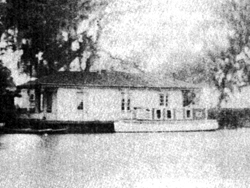
Houseboats could function as either a primary or secondary residence. Vernie Gibson stated that the advantage of houseboat living to the commercial fisherman was a logistical one - being where you needed to be for work." The boat could be moved to seining areas, then taken directly to French Fork where the buyers were located, affording the boat dwellers a jump on competitors The boats were propelled by inboard motors; but before such motors were common, three to four men pulled the boat by ropes attached to it. They walked along the shore, dragging the boat behind them. Houseboats of this type and function are probably non-extant today having been replaced by metal houseboats for recreational use only. A residential houseboat of the type described above is featured in Plate 4.
The Skiff
The skiff is a sharp-bowed wooden boat very popular before the advent of the outboard motor. It is rare to see a skiff-type work boat today. When commercial fishermen "pulled" their boats with oars, the skiff was the desired craft. They were sixteen to twenty-four feet long then, with two sets of oarlocks and would easily hold sixteen to seventeen hundred pounds of fish. If skiffs are built at all today, they are rarely more than fourteen to sixteen feet long and have only one set of oars.13
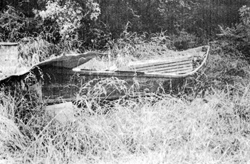
A commercial fisherman himself, Vernie Gibson states, "We used to think a sharp-bowed boat would take the rough water better like it would cut the water." There are many disadvantages of fishing in a skiff. In bayou environments, it has a tendency to bog down in the water, and a trot line pulled in on one side of the boat will cause it to veer in the opposite direction.
The bottom of the skiff is made of marine plywood, and the gunwales are made ideally of heart cypress, although they can be constructed from plywood instead. The headblock and tailboard are made of heart cypress if it is available. As with the pirogue, the frame is constructed first. The gunwales are beveled one and one-half inch to zero on either end, beginning one-third of the way from the bow end at the bending timber. The bending timber is the bottom support from which the bow is pulled in to the headblock. The bending timber is attached to the gunwales first, then the timbers are place approximately fourteen inches apart to the bow. Remaining timbers are placed in the same manner to the stern, and the tailboard is attached. The gunwales are then pulled in from the bending timber and the headblock is attached, raising the bow slightly. For each two-inch pull of the gunwales to the headblock, one inch of "rise" is achieved. The rise is how far the bow lifts up out of the water. The frame is completed, and the bottom piece of the boat is attached.
The skiff was supplanted in popularity among commercial fishermen by the bateau, the most widely-used wooden boat in use on the lake today. The skiff in Plate 5 (still functional, but not in its intended use) now houses a worm bed.
The Bateau
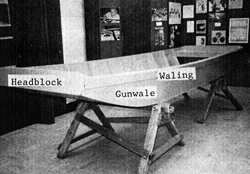
The bateau, also called the johnboat, is the most popular wooden boat built today (Plate 6). Its popularity comes from its stability and ease of handling in most of the lake's environs. The flat bottom and almost square ends provide stability, allowing one to fish from either side of the boat.
The Catahoula Lake-style bateau is approximately fourteen feet long and fifty inches wide at the bending timber, again one-third the boat length from the bow. The flair is three inches wider than the bow, and the gunwales are ideally twenty inches high.
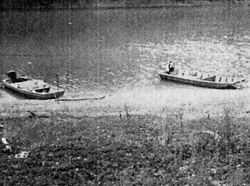
There is some variation in boats constructed by different builders (Plates 5 & 6), but the basic construction techniques are the same. Blocks and gunwales are preferably constructed of heart cypress, and the bottom from marine plywood. Ideally, the gunwales are cut from the same timber, something a good boat builder can usually detect. A solid gunwale is desired, but it can be built up. The tailboard is one and a half to two inches thick because of the tremendous strain on the timbers. The gunwales are straight from the stern to the bending timber, then are pulled in to the headblock to give the bow its rake. The knees, the side support pieces, are one and a quarter inches wide and are regularly spaced inside the gunwales and attached to the bottom timbers. As with boats mentioned above, the frame is constructed first in the same process as with the skiff and is attached to the bottom piece. A waling is often applied around the top of the finished boat. The waling piece is flat at the top and bevels down to the gunwales at the bottom, preventing nets and traps pulled over the edge of the boat from snagging.
Wooden Versus Metal Boats
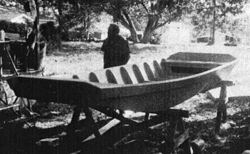
The fishermen who use wooden boats claim that wood absorbs the shock of the waves in Catahoula Lake better than a metal boat. A wooden boat, they say, will outlast several metal boats, since metal ones begin to leak after about a year. In the swamp, the metal boat will clang loudly when it touches an obstruction, such as a cypress knee, while a wooden boat makes a soft "thud."
Although metal boats are equipped with flotation chambers, they will often float with only the bow exposed should they overturn. If a fisherman capsizes in cold water, it is difficult for him to maintain a hold on a metal boat. When offering a reason for his preference for wooden boats, Vernie Gibson said, "There's not a metal boat built safe enough for me yet. I only remember one man drowning in a wooden boat, and he couldn't swim!" Proponents of metal boats cite their light weight and ease of handling. Metal boats are also cheaper. The cost of materials required to build a wooden boat is almost equal to the price of a comparable aluminum boat; however, time and labor almost double the cost.
The Craftsman
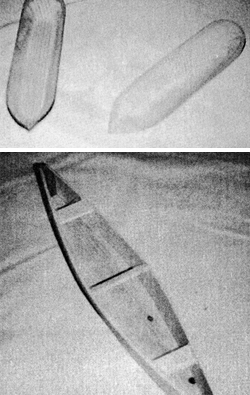
The number of people building wooden boats for their own use or for sale to others has diminished noticeably in the past fifty years. Informants around Catahoula Lake know of only a few practicing boatmakers today. The easy availability of metal boats presages the end of makers of wooden craft. Diminishing supplies of heart cypress and marine lumber have also contributed to the decline. The paucity of heart cypress has forced the boatmaker to use the less desirable sap cypress, the yellow outside layer of the cypress tree that surrounds the heart of the tree. The few boatbuilders left can only hope to pass their craft down to family members as the decreasing demand for wooden boats makes unfeasible a dependence on boatbuilding as the primary source of income. Vernie Gibson, a master boatbuilder, has five grandsons, but none seem interested in carrying on his tradition.
Practitioners of this craft generally keep their plans in their heads, preferring to forego the use of complicated and cumbersome patterns; therefore, their talents die with them. Precision in boatbuilding cannot be taught, but must be learned by trial. Although lacking formal education in many cases, the boatmaker holds complex formulas for adding and taking off pounds, achieving the desired rake and flair, and for building a boat that is even and "runs true"--no simple task.
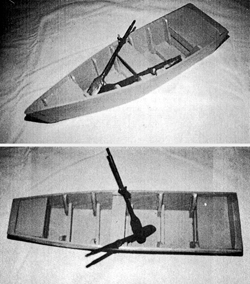
These boatbuilders are not afraid to experiment or modify a given design, and will adapt aspects of designs they have seen to fit their needs. There is an obvious respect for the tools and the wood needed to make a good boat, and there is little excess or waste. Patience is also a necessity. Vernie Gibson states, "It takes a lot of patience to do this, and you better know what you're doing before you start or you waste your time and money."
Carrying on the Catahoula Lake boatbuilding tradition, Joe and Mickey Barron and Boone Kitchens are replicating boat styles of the lake in the form of miniature boats. These miniatures are not toys, but careful examples of the working boats that have characterized the boating tradition on Catahoula Lake in the past (Plates 8 and 9).
The advent of metal boats and the changing ecology of the lake spell the end of production of wooden boats on Catahoula Lake. When the few remaining boatbuilders are gone, there will be no one to take up the tradition. With the loss of this craft, an aspect of material culture that reflects the nature of Catahoula Lake and its people will be gone.
Endnotes
1. Henry Glassie, in Introduction to "Folk Boats of Eastern French Louisiana," by William Knipmeyer, American Folklife, ed. Don Yoder. (Austin: University of Texas Press, 1977), p. 105.
2. William Knipmeyer, "Folk Boats of Eastern French Louisiana," p. 107.
3. Le Page du Pratz, History of Louisiana (1774), trans. Joseph Tregle, Jr. Published for the Louisiana American Revolution Bicentennial Commission, Baton Rouge: LSU Press, pp. 176, 239, 358.
4. H. F. Gregory, "The Black River Commerical Fisheries: A Study in Cultural Geography," Louisiana Studies 5, 1 (Spring 1966), 18.
5. H. F. Gregory, Personal Communication, 1987. Mickey Barron, Personal Communication, 1987.
6. H. F. Gregory, Personal Communication, 1987.
7. Mickey Barron, Personal Communication, 1987.
8. William Knipmeyer, pp. 111-115.
9. Vernie Gibson, Personal Communication, 1986.
10. Vernie Gibson, Personal Communication, 1987.
11. H. F. Gregory, Personal Communication, 1987.
12. Vernie Gibson, Personal Communication, 1986.




